Travis W. Inman's Blog, page 3
September 11, 2015
A Letter Home on 9/11
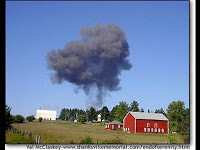 United Airlines Flight 93, crashed down in a field in rural Pennsylvania, never reaching its intended target because its crew and passengers fought back against the terrorists. I offer you a first had story of what happened:
United Airlines Flight 93, crashed down in a field in rural Pennsylvania, never reaching its intended target because its crew and passengers fought back against the terrorists. I offer you a first had story of what happened:September 11, 2001
My Dearest Caroline,My heart was heavy as we left you and the kids this morning. Somehow I felt a special connection with you as we warmly embraced and tenderly kissed goodbye. Oh, how I hate saying goodbye to you. My only consolation is that I will get to see you again soon, to feel your gentle arms surround me in welcoming me home. Even though I will only be gone a few days, I will miss you tremendously, for I am incomplete when I am separated from those who fill my heart with love.
James whispered in my ear to tell you hello, then proceeded to tease me for writing such emotional words. Sometimes I think that he belittles me for my expressions of love. He’s a man's man and doesn't seem to find much time for love in his life. I can only imagine how lonely his wife and kids must be. Yet, despite his brash criticism of me and my ways, I still find an appreciation for him. He is James, and can be nothing else.
I know that you hesitated to let me take Little Charles with me on this trip, but he will soon be a man and must learn how to function in this world as a man. Sometimes I find it hard to remember that he is only 10, for he is so confident and mature. I smiled this morning as we boarded the plane. He held open the door in the terminal for an elderly couple, and then he looked at me to see if I noticed. I pretended not to, for I don't want him to act unselfishly just to win my approval. Instead, I want him to do what’s right because it’s the right thing to do. Right now he’s sleeping, his poor little head is dangling awkwardly, but he seems content for the moment. As soon as we land, I’ll call and let you know that we made it safely. Then I’ll email this letter to you at home. I marvel at our new technologies that allow me to communicate with you in so many fashions. Hold on a minute, someone is trying to tell us something...
Dear, I have bad news. One of the passengers was talking on the phone and was telling us that a plane just flew into the World Trade Center in New York. If that is so, we may not be able to return for several more days. They think that it was a terrorist act, but that seems impossible. Nothing like that would happen here in the United States. Well, that passenger just told us that a second plane has hit the towers. Oh my, I guess that we are under attack... I’ll take a few minutes and explain to Charles what’s happening. Some of the other passengers are afraid that something might happen to us. I doubt that. It would be way too hard to orchestrate. Imagine that, in only a few minutes, our whole world changed. May God have mercy on us all...
Well, I'm back. Charles is sitting wide eyed next to me, trying not to be afraid. I told him that it’s okay to be afraid, but not to let his fear control him. He asked if we were going to die. I almost told him yes, as we are all going to die. We all know that. There is appointed a day for all of us to die, and few us know when that day is coming. But I told him that we would land safely. Now I wonder if I lied to him just to make him comfortable. Why am I unwilling to tell him of the distant threat that we might all be in as we fly through the sky? I guess that I just want to protect him, but he will be a man someday and he must know how to deal with the truth.
Charles has now asked me what we would do if we knew that our plane was going to be flown into the World Trade Center. I told him that I didn't know. Then he became fearful of dying. A natural reaction, I suppose. But we have guided him to live a life where he would be ready to die if God called his name. He said that he wanted to make sure, so he closed his eyes and appeared to be praying. We then talked about those people on the planes and why they didn't stop the terrorists. I told him that we need to have the courage to do what’s right, even if it meant our own deaths. We seldom hear of people unselfishly sacrificing themselves for their brothers any more. But it was a good opportunity for me to talk to Charles about being a hero. To me, if we were to be taken over by terrorists, then I would find a way to stop them or die trying. Not that being a hero is a great reward, but I couldn’t face my family if I dishonored them by cowering down behind my seat. After all, how many lives could have been spared if the people on those planes had stopped the terrorists?
Wow. I have something to tell you. A group of Arabs just stood up and started to take over this plane. Oh my gosh... this is real. I have so much to tell you, but I am out of time. When the highjackers weren't looking, a guy named Todd just came past my chair and we are organizing a resistance. Baby, I may die, and Charles with me, but I have to do what is right. We can't let this group kill any innocent lives, we have to stop them. Imagine the odds of me talking about this exact topic with Charles and then me having an opportunity to actually instruct him for real! Sweetheart, these are probably my final words to you. Know that I love you with all my heart. I am sorry that I couldn't have loved you more and I am sorry for all the times that I chose to be selfish instead of giving to you. I deeply cherish all that we are.... I don't regret one minute of what we shared. Oh, how I love the kids. Tell them to serve God with all their hearts and strength. Tell them that I love them and that I am proud of them. Tell them that I was given an opportunity to choose between being a victim and a hero. Tell them that I chose not to die an ordinary death, but I died defending my family and my country. Is there a greater honor? I have to go, its time, at Todd said, “Let’s roll.”
I love you and I hope that you receive this letter. See you at the East Gate! Your loving husband,
Bill
I don't know how many lives were saved because these heroes sacrificed their lives to protect us, but may God bless their survivors. These few are not forgotten.

Published on September 11, 2015 09:58
September 7, 2015
Leah Atwood
My day with Leah Atwood:But first, a peek at her newest release:
Come To Me Again
 Dominic Sellers dreamed of escaping a life of poverty and making a living playing music. On the brink of giving up, he’s offered the chance of a lifetime to be the new guitarist for Bryce Landry. His life finally aligned with his goals, but something was missing.
Dominic Sellers dreamed of escaping a life of poverty and making a living playing music. On the brink of giving up, he’s offered the chance of a lifetime to be the new guitarist for Bryce Landry. His life finally aligned with his goals, but something was missing.
Four years ago, Maisy Rothchild walked away from her fiancé—her best friend and the only man she’d ever loved. She’d give anything to go back and change that day, but that wasn’t possible. There were factors that complicated the situation, things she couldn’t tell anyone.
When she makes a bold move to restore their friendship, can the same love that tore them apart bring them back together?
___________________ What a privilege for me to hang out with Leah for a little while and chat with her about her books. I’m so proud for this opportunity.
What a privilege for me to hang out with Leah for a little while and chat with her about her books. I’m so proud for this opportunity.
Q. How many books have you published? How many series?
Oh man, you didn’t tell me I’d have to do math. J Let’s see. I began with the Mail-Order Matches short stories. There are nine of those. The Brides of Weatherton series currently has three book, but will have five total and the Come to Me Series has three, and will get a bonus Christmas novella. Last but not least is the Freedom Bride series on which I collaborated with Susette Williams. There are six in that series, three of them from me. So let’s see—that’s eighteen that I’ve published and are available.
Q. What do you enjoy most about writing historical fiction, and how did you get started in that genre?
They say to write what you love and the period of American westward expansion has always fascinated me. The men and woman who pushed west and paved new roads for everyone else have such stories or bravery, courage and perseverance. I would love if time-travel existed so I could experience it firsthand, but since it doesn’t, I have to live vicariously through my characters.
Q. You excel at historical fiction. Why did you decide to venture away from that and start a new modern day series?
Contemporary romance was always part of the equation, but the story I was working on never felt right. A conversation with a friend was the catalyst for Come to Me Alive and the characters came to life, begging for more stories. Funny, that series had spurred new ideas for the original series I planned but could never get the plots where I wanted, and it will now be a spin-off from the Come to Me books.
Q. You have a unique talent for making your stories light hearted and charming. Is that something you do deliberately, or do you even realize you do so?
Is there such a thing as a deliberate subconscious? I write “inspirational romance to make your heart happy,” so there is a definite decision to keep them light-hearted, but I let the characters write the story. Seriously. If you ever see me talking to no one in particular, I’m not crazy, but probably talking out a conversation between two characters.
Q. You have a series about mail order brides. How did that come to be?
Again, the idea absolutely fascinates me. Marriage is hard enough under normal circumstances, but to a complete stranger? And to move clear across the country in many cases? My husband (then fiancé) and I knew each other a very short time when I moved across the country to stay near him when he transferred, and even though I knew him that was scary (but very rewarding!). I don’t know that I would have had the courage to make that move had he been a complete stranger.
Q. You have been transitioning several of your novels into audio books. Do you plan to make all of your novels available with audio?
I do. I actually made a contract offer today for another one. It’s not a quick process, but hopefully by next summer my entire backlist will be available and all new works will have an accompanying audio version within two months.
Q. What is next for you?
Right now, I’m working on two Christmas novellas that will tie up the Brides of Weatherton and Come to Me series. I have a fun little contemporary series planned for this winter about modern day marriages of conveniences, and then next year, the to-be-titled Come to Me spin-off and a new historical series set in South Dakota.
Q. You are completely a self-start author, beginning with your first book, and you are very successful. Why did you choose to be self-published, knowing that you had opportunities to be traditionally published?
For me, this was the best choice. I have the freedom to write as I please, juggle contemporary and historical series. I have full control over everything I put out and I can get it to my reader’s in a quicker timeframe than traditional publishing would allow. Each person has to make their own decision based on what’s best for their goals and needs—which might be going the trad pub route for someone else, but for now, I’m very happy with my choice.
Q. How much discipline does it take to be a full time writer? Can you describe your ordinary work week?
It takes a lot! I don’t have a set schedule because I try very hard to maintain a balance between work and family. Until the last few weeks, I still had a child home with me, so it meant a lot of late nights and early mornings to maintain a full writing schedule. Now it’s a bit easier and I can do a solid six hours during the day and only a few in the evening. On any given week, I probably put in about fifty hours, but not all of that is strictly writing. There’s a lot of behind the scenes work that also comes with the territory, but those tasks help break up the mental wear of straight writing.
Q. Who is your favorite writer?
Other than you? Haha. Let’s see, that’s another toughie. I absolutely love Rosanne Bittner’s books and really hope she publishes more faith fiction. Where Heaven Begins is one of the most beautiful stories I have ever read! It stays with you long after you read it.
Q. What advice would you give an emerging writer who wants to follow in your footsteps?
Writing is a fun and rewarding job, but it requires a tremendous amount of work and dedication. Learn your craft. Find a network of other writers from whom who can learn and grow. Always be willing to learn, and in return help others who are just beginning.
Bonus round:Q. What was your favorite Christmas present ever?
I’m not sure that it’s my favorite, but it’s the most memorable. Back in the day when Nintendo first came out, my parents bought it for me and my brothers to share. For some reason, we were allowed to open it Christmas Eve. (Generally, the Christmas Eve present was reserved for pajamas, but knowing how my mom, she was super excited to give it to us.) At some point during the middle of the night, my brothers and I all woke up and sat in front of the TV playing Super Mario Brothers. My dad came in sometime around three and made us go back to bed, but I still look back with a smile every time I think of it. It’s one of those fun memories we still joke about. By the way, Santa’s cookies were still on the table when we first started playing.
Q. How can readers keep up with what’s going on in your world?
Follow me on Facebook https://www.facebook.com/LeahAtwoodAuthor?ref=hl
Or Join my Newsletter
What a great interview with a top notch writer! I deeply respect Leah’s writing craft and I look forward to what she has in store for the future. Leah has a very positive and light hearted way of expressing herself and those qualities define her characters. If you’ve never had the opportunity to read her books, I strongly encourage you to do so—sooner rather than later. Leah delivers time and again, and I think she will continue to improve her flawless method as she goes. Perfection being perfected.
You’ll see!
Come To Me Again
 Dominic Sellers dreamed of escaping a life of poverty and making a living playing music. On the brink of giving up, he’s offered the chance of a lifetime to be the new guitarist for Bryce Landry. His life finally aligned with his goals, but something was missing.
Dominic Sellers dreamed of escaping a life of poverty and making a living playing music. On the brink of giving up, he’s offered the chance of a lifetime to be the new guitarist for Bryce Landry. His life finally aligned with his goals, but something was missing. Four years ago, Maisy Rothchild walked away from her fiancé—her best friend and the only man she’d ever loved. She’d give anything to go back and change that day, but that wasn’t possible. There were factors that complicated the situation, things she couldn’t tell anyone.
When she makes a bold move to restore their friendship, can the same love that tore them apart bring them back together?
___________________
 What a privilege for me to hang out with Leah for a little while and chat with her about her books. I’m so proud for this opportunity.
What a privilege for me to hang out with Leah for a little while and chat with her about her books. I’m so proud for this opportunity. Q. How many books have you published? How many series?
Oh man, you didn’t tell me I’d have to do math. J Let’s see. I began with the Mail-Order Matches short stories. There are nine of those. The Brides of Weatherton series currently has three book, but will have five total and the Come to Me Series has three, and will get a bonus Christmas novella. Last but not least is the Freedom Bride series on which I collaborated with Susette Williams. There are six in that series, three of them from me. So let’s see—that’s eighteen that I’ve published and are available.
Q. What do you enjoy most about writing historical fiction, and how did you get started in that genre?
They say to write what you love and the period of American westward expansion has always fascinated me. The men and woman who pushed west and paved new roads for everyone else have such stories or bravery, courage and perseverance. I would love if time-travel existed so I could experience it firsthand, but since it doesn’t, I have to live vicariously through my characters.
Q. You excel at historical fiction. Why did you decide to venture away from that and start a new modern day series?
Contemporary romance was always part of the equation, but the story I was working on never felt right. A conversation with a friend was the catalyst for Come to Me Alive and the characters came to life, begging for more stories. Funny, that series had spurred new ideas for the original series I planned but could never get the plots where I wanted, and it will now be a spin-off from the Come to Me books.
Q. You have a unique talent for making your stories light hearted and charming. Is that something you do deliberately, or do you even realize you do so?
Is there such a thing as a deliberate subconscious? I write “inspirational romance to make your heart happy,” so there is a definite decision to keep them light-hearted, but I let the characters write the story. Seriously. If you ever see me talking to no one in particular, I’m not crazy, but probably talking out a conversation between two characters.
Q. You have a series about mail order brides. How did that come to be?
Again, the idea absolutely fascinates me. Marriage is hard enough under normal circumstances, but to a complete stranger? And to move clear across the country in many cases? My husband (then fiancé) and I knew each other a very short time when I moved across the country to stay near him when he transferred, and even though I knew him that was scary (but very rewarding!). I don’t know that I would have had the courage to make that move had he been a complete stranger.
Q. You have been transitioning several of your novels into audio books. Do you plan to make all of your novels available with audio?
I do. I actually made a contract offer today for another one. It’s not a quick process, but hopefully by next summer my entire backlist will be available and all new works will have an accompanying audio version within two months.
Q. What is next for you?
Right now, I’m working on two Christmas novellas that will tie up the Brides of Weatherton and Come to Me series. I have a fun little contemporary series planned for this winter about modern day marriages of conveniences, and then next year, the to-be-titled Come to Me spin-off and a new historical series set in South Dakota.
Q. You are completely a self-start author, beginning with your first book, and you are very successful. Why did you choose to be self-published, knowing that you had opportunities to be traditionally published?
For me, this was the best choice. I have the freedom to write as I please, juggle contemporary and historical series. I have full control over everything I put out and I can get it to my reader’s in a quicker timeframe than traditional publishing would allow. Each person has to make their own decision based on what’s best for their goals and needs—which might be going the trad pub route for someone else, but for now, I’m very happy with my choice.
Q. How much discipline does it take to be a full time writer? Can you describe your ordinary work week?
It takes a lot! I don’t have a set schedule because I try very hard to maintain a balance between work and family. Until the last few weeks, I still had a child home with me, so it meant a lot of late nights and early mornings to maintain a full writing schedule. Now it’s a bit easier and I can do a solid six hours during the day and only a few in the evening. On any given week, I probably put in about fifty hours, but not all of that is strictly writing. There’s a lot of behind the scenes work that also comes with the territory, but those tasks help break up the mental wear of straight writing.
Q. Who is your favorite writer?
Other than you? Haha. Let’s see, that’s another toughie. I absolutely love Rosanne Bittner’s books and really hope she publishes more faith fiction. Where Heaven Begins is one of the most beautiful stories I have ever read! It stays with you long after you read it.
Q. What advice would you give an emerging writer who wants to follow in your footsteps?
Writing is a fun and rewarding job, but it requires a tremendous amount of work and dedication. Learn your craft. Find a network of other writers from whom who can learn and grow. Always be willing to learn, and in return help others who are just beginning.
Bonus round:Q. What was your favorite Christmas present ever?
I’m not sure that it’s my favorite, but it’s the most memorable. Back in the day when Nintendo first came out, my parents bought it for me and my brothers to share. For some reason, we were allowed to open it Christmas Eve. (Generally, the Christmas Eve present was reserved for pajamas, but knowing how my mom, she was super excited to give it to us.) At some point during the middle of the night, my brothers and I all woke up and sat in front of the TV playing Super Mario Brothers. My dad came in sometime around three and made us go back to bed, but I still look back with a smile every time I think of it. It’s one of those fun memories we still joke about. By the way, Santa’s cookies were still on the table when we first started playing.
Q. How can readers keep up with what’s going on in your world?
Follow me on Facebook https://www.facebook.com/LeahAtwoodAuthor?ref=hl
Or Join my Newsletter
What a great interview with a top notch writer! I deeply respect Leah’s writing craft and I look forward to what she has in store for the future. Leah has a very positive and light hearted way of expressing herself and those qualities define her characters. If you’ve never had the opportunity to read her books, I strongly encourage you to do so—sooner rather than later. Leah delivers time and again, and I think she will continue to improve her flawless method as she goes. Perfection being perfected.
You’ll see!
Published on September 07, 2015 13:27
August 25, 2015
Connecting with your Kids: Fort Bella
Difficulty level: highTools needed: Axe, shovel, power drill, level, power saw, tape measureBuild time: 1 weekCost: around 300.00Spending time with my kids? Priceless!
I love spending time with my kids, and they are always at an age when they need to spend time with me. This project took us two years to finish. TWO YEARS! It should have taken 1 week, but, shortly after we started building, I fell down and broke some ribs, and then winter came. The next year I was sent out of town for my work and didn’t have any summer time left, and then winter came. Well, this year, I hurt myself again! (Apparently, I’m not 20 anymore, but I still try to work like I am.) But, despite it all, I was determined to finish this project.
Living in the Idaho panhandle, we have resources you might not have. For instance, I was able to buy enough logs to build this fort out of real pine trees. But, you can do the same thing using fence poles, especially if you buy the poles that are already pointed. They look like pencils!
So, our first step was to select a building site. This is what our back yard looks like....
 The previous year, we built a teepee for the kids near the neighbor's fence on the side of the yard. That site only allowed for two walls to be constructed, but the kids wanted the teepee and the fort to be close together.
The previous year, we built a teepee for the kids near the neighbor's fence on the side of the yard. That site only allowed for two walls to be constructed, but the kids wanted the teepee and the fort to be close together.
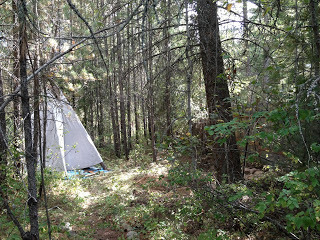 We will place it next to the teepeeWe began the task of digging out the footings...
We will place it next to the teepeeWe began the task of digging out the footings...
 We never found gold...just river rocks.
We never found gold...just river rocks.


The footings were dug 18-24 inches deep. In some places, 18 inches was all I could get. We will use the rocks later to place around the logs and help reinforce them. So, footings are dug, we need logs. I ordered a load of logs to come to the house. I paid 10.00 for each log. They were 12 feet long and about 10 inches across. I wanted logs that were 6-8 inches, but that's what was delivered.

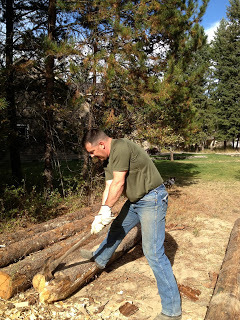
You have to be super careful doing this. The axe will glance off the log. Trust me. This is not something you do carelessly.
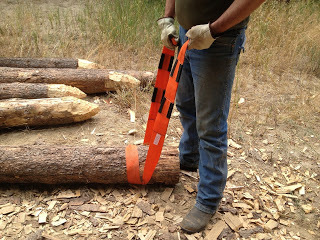
The next difficult task is to get the logs from point A to B. I decided to use some furniture moving straps, which allows my arms to be the forklift. It worked, but it was a hard task. The kids helped, too. They weren't as happy about this part of the process.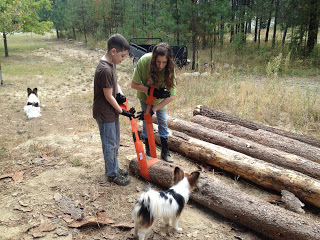 The kids each held one end of the straps
The kids each held one end of the straps
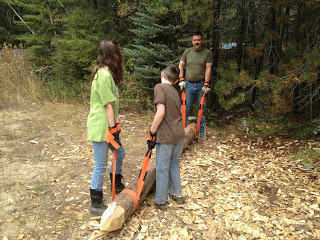 It took coordination and patience to get a rhythm together.
It took coordination and patience to get a rhythm together.
 This was not as easy as it looks, but we figured it out.Next, we have to place the logs into the footings. The kids had to help me. I did the lifting, and they helped brace them in place until I could secure them using some 2X4s and five inch decking screws.
This was not as easy as it looks, but we figured it out.Next, we have to place the logs into the footings. The kids had to help me. I did the lifting, and they helped brace them in place until I could secure them using some 2X4s and five inch decking screws.


You want to make sure the 2X4s are level, as they will be used to for the decking in the next step.


I placed some cross braces took keep everything from moving around. This is the point where I was injured and we had to put the project on hold. For 2 years! When we got back in motion, everything was just as we left it, which is a good thing. Next, we needed to build the decking. We designed the fort to have two decks. The lower deck serves as a step to get to the upper deck. This is why we didn’t cover the entire surface of the lower deck. Plus, my son thought it would be cool to have an opening to crawl through to the ground below. The first level is more of a stepping platform to the upper level. I placed some concrete blocks to use to support the decks across the length of the triangle shaped decks. The span from one end to the other was about 11 feet long. So, I placed the block, and used a 4X4 post to help support the 2X4 frame. We then used 2X6 boards to cover the decks. Don't forget to place at least 1/8 inch between the boards to allow for drainage.
Seth learned a lot about using power tools on this project, and demonstrated skill in his work by the end of the day. He and I had a blast working together! He’s already talking about doing the same thing with his own kids in the future. The concrete piers help reinforce the span.
The concrete piers help reinforce the span.
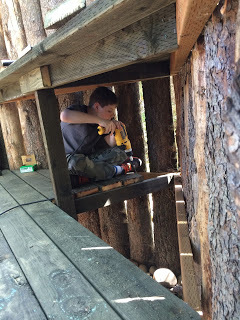 Seth loved using the tools and learned a lot!So, because we needed to maximize space because our building site was limited, we built our walls where the corner was more like 50 degrees rather than a true 45. This made all of our cuts difficult. But, once we figured them out, we were able to get the decking in place in just a few hours. Some tell me I should have run the boards across rather. I’m not sure it matters. I consulted several contractors, and got several opinions. This is the path we chose.
Seth loved using the tools and learned a lot!So, because we needed to maximize space because our building site was limited, we built our walls where the corner was more like 50 degrees rather than a true 45. This made all of our cuts difficult. But, once we figured them out, we were able to get the decking in place in just a few hours. Some tell me I should have run the boards across rather. I’m not sure it matters. I consulted several contractors, and got several opinions. This is the path we chose.
I opted to buy pressure treated lumber, which would help weather our weather. It’s wet here. We get lots of rain. And we get snow in the winter, so longevity is an issue with outdoor decks. The problem with pressure treated lumber is the exposure to chemicals that are used to preserve the wood. One way around this problem is to buy redwood decking materials, which is expensive. Redwood lasts longer than regular pine or fir, and is fairly bug resistant. If you can afford to use redwood, then please do so. Another great option is to use a product such as Trex, which is composite decking. This product is awesome and should last about 25 years. Again, the problem is the price. It is more expensive than buying wood decking. So, I chose to use pressure treated fir.
This was a labor-intensive project. Shaping the logs and transporting them to our building site was tough. Standing them in place required two adults or one adult and two strong kids. Building the deck was not terribly difficult, and was certainly the funnest part of the project. But, look at those smiles!
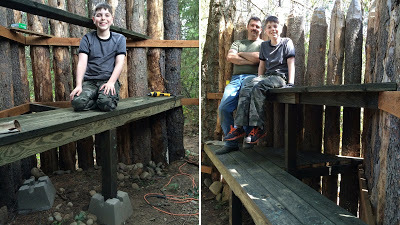
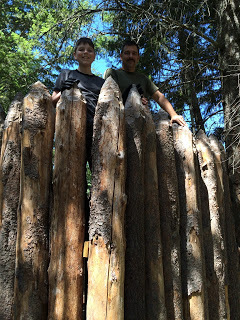
The only thing that remains is to add a flag pole!
I love spending time with my kids, and they are always at an age when they need to spend time with me. This project took us two years to finish. TWO YEARS! It should have taken 1 week, but, shortly after we started building, I fell down and broke some ribs, and then winter came. The next year I was sent out of town for my work and didn’t have any summer time left, and then winter came. Well, this year, I hurt myself again! (Apparently, I’m not 20 anymore, but I still try to work like I am.) But, despite it all, I was determined to finish this project.
Living in the Idaho panhandle, we have resources you might not have. For instance, I was able to buy enough logs to build this fort out of real pine trees. But, you can do the same thing using fence poles, especially if you buy the poles that are already pointed. They look like pencils!
So, our first step was to select a building site. This is what our back yard looks like....
 The previous year, we built a teepee for the kids near the neighbor's fence on the side of the yard. That site only allowed for two walls to be constructed, but the kids wanted the teepee and the fort to be close together.
The previous year, we built a teepee for the kids near the neighbor's fence on the side of the yard. That site only allowed for two walls to be constructed, but the kids wanted the teepee and the fort to be close together. We will place it next to the teepeeWe began the task of digging out the footings...
We will place it next to the teepeeWe began the task of digging out the footings... We never found gold...just river rocks.
We never found gold...just river rocks.


The footings were dug 18-24 inches deep. In some places, 18 inches was all I could get. We will use the rocks later to place around the logs and help reinforce them. So, footings are dug, we need logs. I ordered a load of logs to come to the house. I paid 10.00 for each log. They were 12 feet long and about 10 inches across. I wanted logs that were 6-8 inches, but that's what was delivered.



You have to be super careful doing this. The axe will glance off the log. Trust me. This is not something you do carelessly.

The next difficult task is to get the logs from point A to B. I decided to use some furniture moving straps, which allows my arms to be the forklift. It worked, but it was a hard task. The kids helped, too. They weren't as happy about this part of the process.
 The kids each held one end of the straps
The kids each held one end of the straps
 It took coordination and patience to get a rhythm together.
It took coordination and patience to get a rhythm together.
 This was not as easy as it looks, but we figured it out.Next, we have to place the logs into the footings. The kids had to help me. I did the lifting, and they helped brace them in place until I could secure them using some 2X4s and five inch decking screws.
This was not as easy as it looks, but we figured it out.Next, we have to place the logs into the footings. The kids had to help me. I did the lifting, and they helped brace them in place until I could secure them using some 2X4s and five inch decking screws.

You want to make sure the 2X4s are level, as they will be used to for the decking in the next step.


I placed some cross braces took keep everything from moving around. This is the point where I was injured and we had to put the project on hold. For 2 years! When we got back in motion, everything was just as we left it, which is a good thing. Next, we needed to build the decking. We designed the fort to have two decks. The lower deck serves as a step to get to the upper deck. This is why we didn’t cover the entire surface of the lower deck. Plus, my son thought it would be cool to have an opening to crawl through to the ground below. The first level is more of a stepping platform to the upper level. I placed some concrete blocks to use to support the decks across the length of the triangle shaped decks. The span from one end to the other was about 11 feet long. So, I placed the block, and used a 4X4 post to help support the 2X4 frame. We then used 2X6 boards to cover the decks. Don't forget to place at least 1/8 inch between the boards to allow for drainage.
Seth learned a lot about using power tools on this project, and demonstrated skill in his work by the end of the day. He and I had a blast working together! He’s already talking about doing the same thing with his own kids in the future.
 The concrete piers help reinforce the span.
The concrete piers help reinforce the span.
 Seth loved using the tools and learned a lot!So, because we needed to maximize space because our building site was limited, we built our walls where the corner was more like 50 degrees rather than a true 45. This made all of our cuts difficult. But, once we figured them out, we were able to get the decking in place in just a few hours. Some tell me I should have run the boards across rather. I’m not sure it matters. I consulted several contractors, and got several opinions. This is the path we chose.
Seth loved using the tools and learned a lot!So, because we needed to maximize space because our building site was limited, we built our walls where the corner was more like 50 degrees rather than a true 45. This made all of our cuts difficult. But, once we figured them out, we were able to get the decking in place in just a few hours. Some tell me I should have run the boards across rather. I’m not sure it matters. I consulted several contractors, and got several opinions. This is the path we chose.I opted to buy pressure treated lumber, which would help weather our weather. It’s wet here. We get lots of rain. And we get snow in the winter, so longevity is an issue with outdoor decks. The problem with pressure treated lumber is the exposure to chemicals that are used to preserve the wood. One way around this problem is to buy redwood decking materials, which is expensive. Redwood lasts longer than regular pine or fir, and is fairly bug resistant. If you can afford to use redwood, then please do so. Another great option is to use a product such as Trex, which is composite decking. This product is awesome and should last about 25 years. Again, the problem is the price. It is more expensive than buying wood decking. So, I chose to use pressure treated fir.
This was a labor-intensive project. Shaping the logs and transporting them to our building site was tough. Standing them in place required two adults or one adult and two strong kids. Building the deck was not terribly difficult, and was certainly the funnest part of the project. But, look at those smiles!


The only thing that remains is to add a flag pole!
Published on August 25, 2015 07:32
June 6, 2015
D-Day, A View From The Section 8
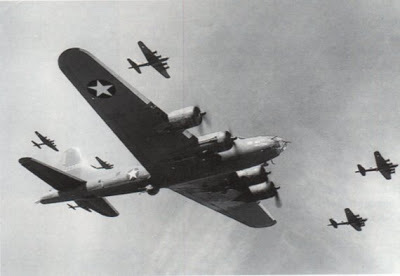
D-Day, June 6, 1944, Normandy
“We flew so low over the beach that I was able to fire on the German’s below. I could see the Army moving along the beaches, but I couldn’t tell exactly what they were doing.” PFC George Pruitt, Ball Turret Gunner
_____________________________________________________
On June 1, 2008, as the summer heat pressed into the windows in Snyder, Texas, I sat interviewing George Pruitt, a former Ball Turret Gunner aboard a B-17D Bomber, who was stationed in England during his tour of duty in World War II. The Ball Turret is the small bubble located on the belly of the B-17D Bomber, AKA "Flying Fortress."
A native of Ardmore, Oklahoma, George had been working with the Civilian Conservation Corps, otherwise known as the CCC, when he heard the news about the Japanese bombing Pearl Harbor. “I had been working in Wyoming and was headed back home when our bus stopped at a hole-in-the-wall diner in Denver, Colorado for lunch. We heard the news broadcast announce the attack. The next day, I joined the Army Air Corps.”
George didn’t wait to be drafted. “No, I knew what I had to do immediately. My brother joined on the same day, but neither of us knew it.” I asked him if he was worried about joining the war, but he smiled and replied, “No, we knew we were going to win before we ever left.”
But leaving took a while. First, he had to endure basic training at Randolph Field in San Antonio, Texas. From there, he attended a series of schools from South Dakota to Pyote, Texas training him how to be a gunner and how to function as a bombardier. He recalled flying over Carlsbad, New Mexico, where they dropped dummy bombs on targets carved out of the dessert for just such a purpose. (These targets can still be seen in Carlsbad, and dummy bomb made from concrete is occasionally unearthed on these sites.)
Once his training was complete, he was assigned to the 452nd Bomb Group/729th Bomb Squadron, and he and his combat crew flew to England and made a home at Deopham Green, just outside of Attleborough in Norfolk. Once they were settled, the flight engineer, Richard J. Walsh, suggested they name their plane, “Section 8”, which was heartily agreed upon. Walsh even managed to get an eight ball painted on the plane. Of course, most Americans will recognize the military term, section 8, which references a discharge based on an assessment of being psychologically unfit or possessing character traits which made one unfit for duty. They figured they were crazy to get in a plane and fly over Germany. Lt. Paul E. Suckow was the pilot for plane #42-31784. Section 8 was now in service.
Throughout the course of a year, the crew of the Section 8 flew 30 missions, which was required of each crew before they could be returned stateside. They had their share of harrowing experiences during their tour of duty. George recalled one instance when a German fighter, was making a sweeping run at them from their right. He began firing at the plane and hit it when it was only 400 yards away. “He’d have gotten us if I hadn’t shot him first,” he recalled, with a distant glance into the past, a tribute to his memory.
And he hadn’t forgotten when the Section 8 was shot down near the end of their tour. “We knew we were going down immediately. They hit the engine and it was all over. We had to ditch the plane into the English Channel. I watched as that plane hit the water and I will never forget how the water flooded over it so quickly.” The crew managed to parachute to temporary safety and they didn’t loose any crew members in that incident. “We were floating in the Channel for about an hour and a half when the shore patrol picked us up. I’ve never been so glad to see a boat in all my life.” George recalled with a smile, “We were given a ditching citation and we immediately became members of the Gold Fish Club.” Their final mission occurred on D-Day. “We left early that morning. I think it was around 2 AM or so. But we were over Normandy just after the sun came up. We bombed several structures and some barracks, and we swept the Germans with our machine guns.”
Of course, their excitement wasn’t limited to their missions in the air. “One night, the RAF (Royal Air Force) shot up our barracks and made us mad. They said it was an accident, but man, what an accident.” Fortunately, no one was hurt. “No, it was mostly just a nuisance.”
Perhaps the most interesting occurrence for George was when he was on leave and was hitchhiking back to the airfield. “We hitched a ride everywhere we went. One day, I was hitching a ride and was surprised to open the door and see Queen Elizabeth. Of course, she was still a princess then, but she was very nice and we chatted for several minutes until they dropped me off.”
The Queen wasn’t the only high profile figures he encountered overseas. “Once, I met both Doris Day and Betty Grabble when they came through doing a tour. I think meeting Doris Day was the best part of my being there.”
After his part was played, George and the crew returned stateside and cheered on the boys who continued the fight. “Those were different days. Everyone knew what their part was, and everyone did what was expected of them. None of us complained; we just did what we had to do.” Once back in the States, George met Martha in Fort Worth, Texas, who was working at piecing together planes for the war cause. “She was my ‘Rosie Riveter’, and I knew I better marry her if I knew what was good for me.” Then, after a scowl from Martha, he winked at me and clarified. "She wasn't Rosie Riveter; she was much prettier." (Martha wanted clarification that she was never, ever a riveter. I think George had a way of teasing his wife, right up to the very end.)
The Pruitts were happily married for more than 60 years, and resided in Hamlin, Texas for most of those years. George died shortly after this interview, and Martha now lives in Snyder, Texas, where she is continually surrounded by family. I count it an honor to have an opportunity to sit in the presence of such great men as George Pruitt. Without the contribution those men and women made, we’d be drinking French wine with German labels, and the maps would be drawn differently than they are currently.
Thank you, George, for the sacrifice you were willing to make in order to guarantee our freedoms. May God richly bless you and your family.
Part II of George's story taken from his personal journal .
Published on June 06, 2015 08:41
May 26, 2015
The Relay Disaster
In my last post about my school days, I described my graduation ceremony from my home-school alma mater, Christian Fellowship Academy, and the quirky things that happened to me at the graduation. I also promised to tell you a story about a track meet I attended where I actually entered into the Twilight Zone. Seriously, at this track meet, I was asked by a man with a gun to leave the track…where do I begin?Life at Christian Fellowship Academy was different from public school. One of the most noticeable features was a complete absence of organized physical activities. Even though we never participated together in any athletic events or activities, the school decided we should enter a track event when we gathered to compete with other Christian schools throughout the Great State of Texas, a decision that still makes me scratch my head. Once a year, we would travel to different locations and compete in various events ranging from singing to track and field. For the glory and honor of my school, I entered photography, checkers, poetry writing, short story, preaching, choir, and (under much protest) the quarter mile relay. Perhaps I’ll find an opportunity to tell you about these events…more stories of the strange and unusual happened at these proceedings, and are each worth telling. But for now, let’s stick with track.Track and field activities were the most respectable and dignified events to enter, weighing much heavier than checkers in importance. All the students and staff gathered to watch their most favored athletes carry on the school traditions and bring great honor to their school’s name. Excelling in these events was the key to understanding and gaining prominence and prestige among your peers. No one except your mom really cared if you won a checkers competition. The big trophy came from the event that now lay before us: track.
 I begged our school not to create a track team only three weeks before the competitions. I was the only student who had ever run on a track or attended a track meet in a competition, and I was horrible at it. In fact, when my fellow students inquired about the events, I had to explain what a relay was, what hurdles were, and what a high jumper did. Christian Fellowship Academy had four boys who were eligible for track events. I was the oldest at seventeen, then Brant at fifteen, John and Jeb both at fourteen. As there were four of us, it made perfect sense to enter a relay. No one took into account that we had a three-year differential in our ages, and that we would be competing against juniors and seniors, not freshmen and sophomores, like 2/3s our runners were. No one took into account that we had never run. In fact, two of the boys had never run further than a lap around a track at any point in their lives. Never the less, we started training seriously two weeks before the competition. At least we allowed plenty of time for improvement.When I tried to explain how a quarter mile relay operated, my fellow runners asked me questions like, “Where will the girls be sitting?” and “Why do those other guy’s shoes have pointy things on them?” I knew we were in trouble.Jeb had participated in track in elementary school, so he knew about relays and how to hand off the baton. I used Jeb to show the boys how to pace each other and accomplish a smooth handoff. As we didn’t have a baton, I used a stick from a dogwood tree. I placed John in the first leg, Brant in the second, Jeb in the third, and I was the last leg. I showed John how to start and then told him to run as fast as he could to Brant, do the hand off, and then get off the track. On our first day of practice, John grinned and said, “At least I know how to get off the track!” As a team we didn’t perform any better. How could we? You can’t master a sport in one practice session. I do remember that we laughed a lot, and we knew better than to take ourselves too seriously. Hopefully, Jeb and I had enough experience to make up the difference. We practiced a couple of times over the nest two weeks, but we simply didn’t have enough time to get the principles down.On the day of the race, I sat the boys down and made them watch the other runners as they raced. However, they were only interested in the cheerleaders, something I wished to do as well, but I was distracted by an overwhelming sense of doom. I openly desired to be sitting under the bleachers sucking on a goose egg rather than preparing for the inevitable. The relay race started and I had to join my teammates on the field. Like a general before a major campaign who has run out of bullets, I quietly surveyed the battleground that lay before me. After calculating the enemy’s strengths and weaknesses, I knew without doubt that we would be humiliated beyond measure. If only I knew to what degree… First, I took note of the other track teams. They were warming up together, while my team was poking each other with the baton. The other teams were dressed in shorts, tank tops, ankle high socks, and cleated running shoes. My team wore sweat pants and hooded tops, tube socks, and high-top tennis shoes. Yet, John and Brant both managed to wear the same color socks! I watched as Jeb explained, as they were poking each other with the baton, that we wouldn’t really run with a dogwood stick. I smiled when John held up the baton and pretended it was a bugle. Finally, the judges called for us to take our starting positions. Somehow, I had never mentioned to John that the runners would be staggered along the track. When he saw the other teams lining up ahead of him, he tried to tell the starting official that they were cheating. I’m not sure he ever understood the explanation, but he lined up in the first lane and complied with the orders. Despite my efforts to anticipate every detail, I also failed to mention to John that the race would start with a pistol shot. It startled him so badly that he dropped to baton and looked over at me while the other runners were going around the corner. Recovering quickly, he picked up the baton and started running. Brant forgot that he was supposed to lead off before receiving the baton, and stood like a statue until John ran to a stop and handed off to Brant. Brant started his quarter lap sprint, but the other teams had already passed Jeb and were close to my position. I had to step off the track so I wouldn’t get run over. As Brant approached Jeb’s position, Jeb led off a picture perfect lead, but Brant forgot about the lead and started shouting to Jeb that he forgot the baton. Jeb had to go back for it. By this time, I watched as the racers rounded my corner and crossed the finish line. Their race was complete; ours was only half begun. Jeb and I executed our parts with precision, but by the time I crossed the finish line, I had to go around the hurdles they were already placing in my lane. The man with the starting pistol glanced at me curiously and asked me to clear the field so he could start the next race. All told, we ended up with a time just short of two minutes. I can still hear the stadium chuckling as they watched us limp off the field. I will long remember that day. And today, the memory is fun, but at that time, I would have actually collapsed and expired if it were possible to die from embarrassment. I do pray that John, Brant, and Jeb find the same humor in this story as do I. Why not laugh about it? It’s hilarious!
I begged our school not to create a track team only three weeks before the competitions. I was the only student who had ever run on a track or attended a track meet in a competition, and I was horrible at it. In fact, when my fellow students inquired about the events, I had to explain what a relay was, what hurdles were, and what a high jumper did. Christian Fellowship Academy had four boys who were eligible for track events. I was the oldest at seventeen, then Brant at fifteen, John and Jeb both at fourteen. As there were four of us, it made perfect sense to enter a relay. No one took into account that we had a three-year differential in our ages, and that we would be competing against juniors and seniors, not freshmen and sophomores, like 2/3s our runners were. No one took into account that we had never run. In fact, two of the boys had never run further than a lap around a track at any point in their lives. Never the less, we started training seriously two weeks before the competition. At least we allowed plenty of time for improvement.When I tried to explain how a quarter mile relay operated, my fellow runners asked me questions like, “Where will the girls be sitting?” and “Why do those other guy’s shoes have pointy things on them?” I knew we were in trouble.Jeb had participated in track in elementary school, so he knew about relays and how to hand off the baton. I used Jeb to show the boys how to pace each other and accomplish a smooth handoff. As we didn’t have a baton, I used a stick from a dogwood tree. I placed John in the first leg, Brant in the second, Jeb in the third, and I was the last leg. I showed John how to start and then told him to run as fast as he could to Brant, do the hand off, and then get off the track. On our first day of practice, John grinned and said, “At least I know how to get off the track!” As a team we didn’t perform any better. How could we? You can’t master a sport in one practice session. I do remember that we laughed a lot, and we knew better than to take ourselves too seriously. Hopefully, Jeb and I had enough experience to make up the difference. We practiced a couple of times over the nest two weeks, but we simply didn’t have enough time to get the principles down.On the day of the race, I sat the boys down and made them watch the other runners as they raced. However, they were only interested in the cheerleaders, something I wished to do as well, but I was distracted by an overwhelming sense of doom. I openly desired to be sitting under the bleachers sucking on a goose egg rather than preparing for the inevitable. The relay race started and I had to join my teammates on the field. Like a general before a major campaign who has run out of bullets, I quietly surveyed the battleground that lay before me. After calculating the enemy’s strengths and weaknesses, I knew without doubt that we would be humiliated beyond measure. If only I knew to what degree… First, I took note of the other track teams. They were warming up together, while my team was poking each other with the baton. The other teams were dressed in shorts, tank tops, ankle high socks, and cleated running shoes. My team wore sweat pants and hooded tops, tube socks, and high-top tennis shoes. Yet, John and Brant both managed to wear the same color socks! I watched as Jeb explained, as they were poking each other with the baton, that we wouldn’t really run with a dogwood stick. I smiled when John held up the baton and pretended it was a bugle. Finally, the judges called for us to take our starting positions. Somehow, I had never mentioned to John that the runners would be staggered along the track. When he saw the other teams lining up ahead of him, he tried to tell the starting official that they were cheating. I’m not sure he ever understood the explanation, but he lined up in the first lane and complied with the orders. Despite my efforts to anticipate every detail, I also failed to mention to John that the race would start with a pistol shot. It startled him so badly that he dropped to baton and looked over at me while the other runners were going around the corner. Recovering quickly, he picked up the baton and started running. Brant forgot that he was supposed to lead off before receiving the baton, and stood like a statue until John ran to a stop and handed off to Brant. Brant started his quarter lap sprint, but the other teams had already passed Jeb and were close to my position. I had to step off the track so I wouldn’t get run over. As Brant approached Jeb’s position, Jeb led off a picture perfect lead, but Brant forgot about the lead and started shouting to Jeb that he forgot the baton. Jeb had to go back for it. By this time, I watched as the racers rounded my corner and crossed the finish line. Their race was complete; ours was only half begun. Jeb and I executed our parts with precision, but by the time I crossed the finish line, I had to go around the hurdles they were already placing in my lane. The man with the starting pistol glanced at me curiously and asked me to clear the field so he could start the next race. All told, we ended up with a time just short of two minutes. I can still hear the stadium chuckling as they watched us limp off the field. I will long remember that day. And today, the memory is fun, but at that time, I would have actually collapsed and expired if it were possible to die from embarrassment. I do pray that John, Brant, and Jeb find the same humor in this story as do I. Why not laugh about it? It’s hilarious!
 What we thought we looked like
What we thought we looked like
 What we actually looked like
What we actually looked like
 I begged our school not to create a track team only three weeks before the competitions. I was the only student who had ever run on a track or attended a track meet in a competition, and I was horrible at it. In fact, when my fellow students inquired about the events, I had to explain what a relay was, what hurdles were, and what a high jumper did. Christian Fellowship Academy had four boys who were eligible for track events. I was the oldest at seventeen, then Brant at fifteen, John and Jeb both at fourteen. As there were four of us, it made perfect sense to enter a relay. No one took into account that we had a three-year differential in our ages, and that we would be competing against juniors and seniors, not freshmen and sophomores, like 2/3s our runners were. No one took into account that we had never run. In fact, two of the boys had never run further than a lap around a track at any point in their lives. Never the less, we started training seriously two weeks before the competition. At least we allowed plenty of time for improvement.When I tried to explain how a quarter mile relay operated, my fellow runners asked me questions like, “Where will the girls be sitting?” and “Why do those other guy’s shoes have pointy things on them?” I knew we were in trouble.Jeb had participated in track in elementary school, so he knew about relays and how to hand off the baton. I used Jeb to show the boys how to pace each other and accomplish a smooth handoff. As we didn’t have a baton, I used a stick from a dogwood tree. I placed John in the first leg, Brant in the second, Jeb in the third, and I was the last leg. I showed John how to start and then told him to run as fast as he could to Brant, do the hand off, and then get off the track. On our first day of practice, John grinned and said, “At least I know how to get off the track!” As a team we didn’t perform any better. How could we? You can’t master a sport in one practice session. I do remember that we laughed a lot, and we knew better than to take ourselves too seriously. Hopefully, Jeb and I had enough experience to make up the difference. We practiced a couple of times over the nest two weeks, but we simply didn’t have enough time to get the principles down.On the day of the race, I sat the boys down and made them watch the other runners as they raced. However, they were only interested in the cheerleaders, something I wished to do as well, but I was distracted by an overwhelming sense of doom. I openly desired to be sitting under the bleachers sucking on a goose egg rather than preparing for the inevitable. The relay race started and I had to join my teammates on the field. Like a general before a major campaign who has run out of bullets, I quietly surveyed the battleground that lay before me. After calculating the enemy’s strengths and weaknesses, I knew without doubt that we would be humiliated beyond measure. If only I knew to what degree… First, I took note of the other track teams. They were warming up together, while my team was poking each other with the baton. The other teams were dressed in shorts, tank tops, ankle high socks, and cleated running shoes. My team wore sweat pants and hooded tops, tube socks, and high-top tennis shoes. Yet, John and Brant both managed to wear the same color socks! I watched as Jeb explained, as they were poking each other with the baton, that we wouldn’t really run with a dogwood stick. I smiled when John held up the baton and pretended it was a bugle. Finally, the judges called for us to take our starting positions. Somehow, I had never mentioned to John that the runners would be staggered along the track. When he saw the other teams lining up ahead of him, he tried to tell the starting official that they were cheating. I’m not sure he ever understood the explanation, but he lined up in the first lane and complied with the orders. Despite my efforts to anticipate every detail, I also failed to mention to John that the race would start with a pistol shot. It startled him so badly that he dropped to baton and looked over at me while the other runners were going around the corner. Recovering quickly, he picked up the baton and started running. Brant forgot that he was supposed to lead off before receiving the baton, and stood like a statue until John ran to a stop and handed off to Brant. Brant started his quarter lap sprint, but the other teams had already passed Jeb and were close to my position. I had to step off the track so I wouldn’t get run over. As Brant approached Jeb’s position, Jeb led off a picture perfect lead, but Brant forgot about the lead and started shouting to Jeb that he forgot the baton. Jeb had to go back for it. By this time, I watched as the racers rounded my corner and crossed the finish line. Their race was complete; ours was only half begun. Jeb and I executed our parts with precision, but by the time I crossed the finish line, I had to go around the hurdles they were already placing in my lane. The man with the starting pistol glanced at me curiously and asked me to clear the field so he could start the next race. All told, we ended up with a time just short of two minutes. I can still hear the stadium chuckling as they watched us limp off the field. I will long remember that day. And today, the memory is fun, but at that time, I would have actually collapsed and expired if it were possible to die from embarrassment. I do pray that John, Brant, and Jeb find the same humor in this story as do I. Why not laugh about it? It’s hilarious!
I begged our school not to create a track team only three weeks before the competitions. I was the only student who had ever run on a track or attended a track meet in a competition, and I was horrible at it. In fact, when my fellow students inquired about the events, I had to explain what a relay was, what hurdles were, and what a high jumper did. Christian Fellowship Academy had four boys who were eligible for track events. I was the oldest at seventeen, then Brant at fifteen, John and Jeb both at fourteen. As there were four of us, it made perfect sense to enter a relay. No one took into account that we had a three-year differential in our ages, and that we would be competing against juniors and seniors, not freshmen and sophomores, like 2/3s our runners were. No one took into account that we had never run. In fact, two of the boys had never run further than a lap around a track at any point in their lives. Never the less, we started training seriously two weeks before the competition. At least we allowed plenty of time for improvement.When I tried to explain how a quarter mile relay operated, my fellow runners asked me questions like, “Where will the girls be sitting?” and “Why do those other guy’s shoes have pointy things on them?” I knew we were in trouble.Jeb had participated in track in elementary school, so he knew about relays and how to hand off the baton. I used Jeb to show the boys how to pace each other and accomplish a smooth handoff. As we didn’t have a baton, I used a stick from a dogwood tree. I placed John in the first leg, Brant in the second, Jeb in the third, and I was the last leg. I showed John how to start and then told him to run as fast as he could to Brant, do the hand off, and then get off the track. On our first day of practice, John grinned and said, “At least I know how to get off the track!” As a team we didn’t perform any better. How could we? You can’t master a sport in one practice session. I do remember that we laughed a lot, and we knew better than to take ourselves too seriously. Hopefully, Jeb and I had enough experience to make up the difference. We practiced a couple of times over the nest two weeks, but we simply didn’t have enough time to get the principles down.On the day of the race, I sat the boys down and made them watch the other runners as they raced. However, they were only interested in the cheerleaders, something I wished to do as well, but I was distracted by an overwhelming sense of doom. I openly desired to be sitting under the bleachers sucking on a goose egg rather than preparing for the inevitable. The relay race started and I had to join my teammates on the field. Like a general before a major campaign who has run out of bullets, I quietly surveyed the battleground that lay before me. After calculating the enemy’s strengths and weaknesses, I knew without doubt that we would be humiliated beyond measure. If only I knew to what degree… First, I took note of the other track teams. They were warming up together, while my team was poking each other with the baton. The other teams were dressed in shorts, tank tops, ankle high socks, and cleated running shoes. My team wore sweat pants and hooded tops, tube socks, and high-top tennis shoes. Yet, John and Brant both managed to wear the same color socks! I watched as Jeb explained, as they were poking each other with the baton, that we wouldn’t really run with a dogwood stick. I smiled when John held up the baton and pretended it was a bugle. Finally, the judges called for us to take our starting positions. Somehow, I had never mentioned to John that the runners would be staggered along the track. When he saw the other teams lining up ahead of him, he tried to tell the starting official that they were cheating. I’m not sure he ever understood the explanation, but he lined up in the first lane and complied with the orders. Despite my efforts to anticipate every detail, I also failed to mention to John that the race would start with a pistol shot. It startled him so badly that he dropped to baton and looked over at me while the other runners were going around the corner. Recovering quickly, he picked up the baton and started running. Brant forgot that he was supposed to lead off before receiving the baton, and stood like a statue until John ran to a stop and handed off to Brant. Brant started his quarter lap sprint, but the other teams had already passed Jeb and were close to my position. I had to step off the track so I wouldn’t get run over. As Brant approached Jeb’s position, Jeb led off a picture perfect lead, but Brant forgot about the lead and started shouting to Jeb that he forgot the baton. Jeb had to go back for it. By this time, I watched as the racers rounded my corner and crossed the finish line. Their race was complete; ours was only half begun. Jeb and I executed our parts with precision, but by the time I crossed the finish line, I had to go around the hurdles they were already placing in my lane. The man with the starting pistol glanced at me curiously and asked me to clear the field so he could start the next race. All told, we ended up with a time just short of two minutes. I can still hear the stadium chuckling as they watched us limp off the field. I will long remember that day. And today, the memory is fun, but at that time, I would have actually collapsed and expired if it were possible to die from embarrassment. I do pray that John, Brant, and Jeb find the same humor in this story as do I. Why not laugh about it? It’s hilarious!  What we thought we looked like
What we thought we looked like What we actually looked like
What we actually looked like
Published on May 26, 2015 07:00
May 23, 2015
SSG Jimmie Doyle
Not everyone can be a hero. Some people will never be given the opportunity to make a difference to untold millions. Some people will never have a chance at true greatness.
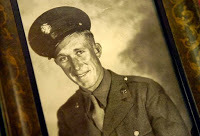 And then there’s Jimmie Doyle. Jimmie was a Texas boy who hailed from McKinney. When WWII broke out, Jimmie left his wife, Myrle, and 15 month old son, Tommy, and shipped out overseas. A member of the 307th Bombardment Group, 424th Squadron, U.S. Army Air Corps, Jimmy served in the South Pacific and was a nose gunner on a B-24J Liberator bomber. He, along with thousands of men like him, regularly squeezed inside a bomber in order to fly into the face of the enemy and into a hell-storm of anti-aircraft artillery. Once they dropped their pay load, they would return to base and await their next run.
And then there’s Jimmie Doyle. Jimmie was a Texas boy who hailed from McKinney. When WWII broke out, Jimmie left his wife, Myrle, and 15 month old son, Tommy, and shipped out overseas. A member of the 307th Bombardment Group, 424th Squadron, U.S. Army Air Corps, Jimmy served in the South Pacific and was a nose gunner on a B-24J Liberator bomber. He, along with thousands of men like him, regularly squeezed inside a bomber in order to fly into the face of the enemy and into a hell-storm of anti-aircraft artillery. Once they dropped their pay load, they would return to base and await their next run.
By August 1944, the Japanese were being forced from tiny islands scattered through the Pacific Ocean and retreating closer to the Japanese mainland. The island of Palau was deep in enemy territory, and was defended by more than 35,000 troops and was the regional headquarters for the Imperial Japanese Navy. Furthermore, it was the focal point for General Douglas Macarthur and Admiral Chester Nimitz in a plan to rid the Japanese threat from the Pacific islands. The U.S. Marines were going to make an amphibious landing and take that island. As a member of the 307th, Jimmie’s flight squadron rallied and set out to soften up the target. Even with air support, Palau is remembered as the third bloodiest battle in the Pacific war and has been called “the forgotten corner of hell.”
On September 1, 1944, the men in Jimmy’s crew flew on a bombing run to the island of Koror. From the nose of the plane, Jimmy manned his .50 caliber machine gun and began battling his way across the ocean. Having reached their target, they dropped their payload. Within seconds, their plane was engulfed in a spray of anti-aircraft artillery. The left wing was severed and the plane began to spiral downward. Three parachutes were sighted by other American bombers as the plane splashed into the shallow waters near Palau. Immediately, a Japanese boat set an intercept course for the survivors.
 At this point of the story, I must introduce a group called BentProp Projects.
At this point of the story, I must introduce a group called BentProp Projects.
According to their website, http://www.bentprop.org/index.htm, they are a group of friends, both historians and scuba divers, who “have gone looking for (and found) ships sunk throughout Micronesia during World War II. Early on, my story took a turn, when I switched from searching for ships to searching for planes - more specifically, American aircraft shot down by occupying Japanese forces during fierce combat over the Palau Islands between 1944 and 1945. Over the ensuing half century, these planes and their crews - and even the battles they fought in the Palaus - have become all but forgotten, except, perhaps, by family and the living veterans who flew missions with and knew these crews.” Patrick J. Scannon, MD, PhD, founder. These men and women have dedicated their lives to finding the remains of those honored dead and helping those soldiers return home for proper burial.
 On Saturday, April 25, 2009, at 13:30 hours (1:30 PM), Staff Sergeant Jimmie Doyle was laid to rest in Lamesa, Texas. Aged 25 at the time of his death, Jimmie and 10 others in his crew were killed in that bombing run. The three men who parachuted to safety were picked up by the Japanese and were never seen again.
On Saturday, April 25, 2009, at 13:30 hours (1:30 PM), Staff Sergeant Jimmie Doyle was laid to rest in Lamesa, Texas. Aged 25 at the time of his death, Jimmie and 10 others in his crew were killed in that bombing run. The three men who parachuted to safety were picked up by the Japanese and were never seen again.
Among those who attended the funeral, Pat Mitchell was standing alongside Tommy Doyle, Jimmie’s only son. Pat Mitchell was a corporal in the Marine Corps who served a short distance from Palau in Okinawa during the war. Pat and Jimmie were related by marriage, although neither of them knew the other. Pat, who grew up in Lamesa, married Jimmie’s cousin, Nettie May Taylor in 1947. Pat’s story can be found here.
Since WWI, 88,000 Americans have disappeared at war, never to be seen again. The military services of America refuse to stop looking for them. It is the code of a soldier to “leave no man behind.” For more than 65 years, Jimmie was listed as Missing In Action, MIA, but he has returned home, thanks to the efforts of the BentProp crew. Take a moment on their website and watch the short video clip that honors SSG Doyle. Thanks to these volunteers, Jimmy is able to sleep under the West Texas stars, where he is at home.
Note: I borrowed heavily from an article found at: http://men.style.com/gq/features/full?id=content_6817&pageNum=1
Please visit this site and see the rest of the story.
 And then there’s Jimmie Doyle. Jimmie was a Texas boy who hailed from McKinney. When WWII broke out, Jimmie left his wife, Myrle, and 15 month old son, Tommy, and shipped out overseas. A member of the 307th Bombardment Group, 424th Squadron, U.S. Army Air Corps, Jimmy served in the South Pacific and was a nose gunner on a B-24J Liberator bomber. He, along with thousands of men like him, regularly squeezed inside a bomber in order to fly into the face of the enemy and into a hell-storm of anti-aircraft artillery. Once they dropped their pay load, they would return to base and await their next run.
And then there’s Jimmie Doyle. Jimmie was a Texas boy who hailed from McKinney. When WWII broke out, Jimmie left his wife, Myrle, and 15 month old son, Tommy, and shipped out overseas. A member of the 307th Bombardment Group, 424th Squadron, U.S. Army Air Corps, Jimmy served in the South Pacific and was a nose gunner on a B-24J Liberator bomber. He, along with thousands of men like him, regularly squeezed inside a bomber in order to fly into the face of the enemy and into a hell-storm of anti-aircraft artillery. Once they dropped their pay load, they would return to base and await their next run.By August 1944, the Japanese were being forced from tiny islands scattered through the Pacific Ocean and retreating closer to the Japanese mainland. The island of Palau was deep in enemy territory, and was defended by more than 35,000 troops and was the regional headquarters for the Imperial Japanese Navy. Furthermore, it was the focal point for General Douglas Macarthur and Admiral Chester Nimitz in a plan to rid the Japanese threat from the Pacific islands. The U.S. Marines were going to make an amphibious landing and take that island. As a member of the 307th, Jimmie’s flight squadron rallied and set out to soften up the target. Even with air support, Palau is remembered as the third bloodiest battle in the Pacific war and has been called “the forgotten corner of hell.”
On September 1, 1944, the men in Jimmy’s crew flew on a bombing run to the island of Koror. From the nose of the plane, Jimmy manned his .50 caliber machine gun and began battling his way across the ocean. Having reached their target, they dropped their payload. Within seconds, their plane was engulfed in a spray of anti-aircraft artillery. The left wing was severed and the plane began to spiral downward. Three parachutes were sighted by other American bombers as the plane splashed into the shallow waters near Palau. Immediately, a Japanese boat set an intercept course for the survivors.
 At this point of the story, I must introduce a group called BentProp Projects.
At this point of the story, I must introduce a group called BentProp Projects.According to their website, http://www.bentprop.org/index.htm, they are a group of friends, both historians and scuba divers, who “have gone looking for (and found) ships sunk throughout Micronesia during World War II. Early on, my story took a turn, when I switched from searching for ships to searching for planes - more specifically, American aircraft shot down by occupying Japanese forces during fierce combat over the Palau Islands between 1944 and 1945. Over the ensuing half century, these planes and their crews - and even the battles they fought in the Palaus - have become all but forgotten, except, perhaps, by family and the living veterans who flew missions with and knew these crews.” Patrick J. Scannon, MD, PhD, founder. These men and women have dedicated their lives to finding the remains of those honored dead and helping those soldiers return home for proper burial.
 On Saturday, April 25, 2009, at 13:30 hours (1:30 PM), Staff Sergeant Jimmie Doyle was laid to rest in Lamesa, Texas. Aged 25 at the time of his death, Jimmie and 10 others in his crew were killed in that bombing run. The three men who parachuted to safety were picked up by the Japanese and were never seen again.
On Saturday, April 25, 2009, at 13:30 hours (1:30 PM), Staff Sergeant Jimmie Doyle was laid to rest in Lamesa, Texas. Aged 25 at the time of his death, Jimmie and 10 others in his crew were killed in that bombing run. The three men who parachuted to safety were picked up by the Japanese and were never seen again.Among those who attended the funeral, Pat Mitchell was standing alongside Tommy Doyle, Jimmie’s only son. Pat Mitchell was a corporal in the Marine Corps who served a short distance from Palau in Okinawa during the war. Pat and Jimmie were related by marriage, although neither of them knew the other. Pat, who grew up in Lamesa, married Jimmie’s cousin, Nettie May Taylor in 1947. Pat’s story can be found here.
Since WWI, 88,000 Americans have disappeared at war, never to be seen again. The military services of America refuse to stop looking for them. It is the code of a soldier to “leave no man behind.” For more than 65 years, Jimmie was listed as Missing In Action, MIA, but he has returned home, thanks to the efforts of the BentProp crew. Take a moment on their website and watch the short video clip that honors SSG Doyle. Thanks to these volunteers, Jimmy is able to sleep under the West Texas stars, where he is at home.
Note: I borrowed heavily from an article found at: http://men.style.com/gq/features/full?id=content_6817&pageNum=1
Please visit this site and see the rest of the story.
Published on May 23, 2015 09:00
May 21, 2015
A Prompt Circumstance
The 2015 school year is wrapping up. This time of year always reminds me of my high school days and how much I hated school, and just how fitting my final day in high school was. That day will always be one of the funniest incidences of my youth. I should preface by saying that I now have a GED.
So, I was valedictorian of my graduating class, which might sound impressive until you discover that I was also the very first graduate of my school, Christian Fellowship Academy. Yes, I attended a small, private school, which was basically, a one-room schoolhouse attached to a church, which was out in the middle of a cotton field, which was out in the middle of no where. I would love to tell you that I was outstanding in my field, but I would have to clarify that I was actually out, standing in my field.
Being a homeschool graduate in the 80s was being a pioneer in many ways, and it was certainly unprecedented. As the first graduate of a school, I was allowed some creativity, and the principal commissioned me to choose the school colors! Not many people can boast that claim, (if it’s a claim worth boasting.) I chose blue and white, the colors of Westbrook ISD, my former school before leaving the public school system.
Being the first also presented some challenges that were unique. In order to graduate, I would have to acquire my own graduation gown. I went down to Westbrook and asked if I could order an additional gown when they ordered their blue robes. They agreed to help me and we arranged to have the gown shipped directly to my school. The gowns were scheduled to arrive a week before graduation, but they were shipped late. In fact, the shipment came only two days before graduation, and I was highly stressed over my predicament. However, the real stress began when I opened the box. Somehow, the order got mixed up and they sent me nine red gowns, instead of one blue gown. It was too late to fix the mix-up, so I changed the school colors to red and white. Not many people can claim to have enough influence to change their school’s colors on a moment’s notice! But, it makes for a fun story, so let’s roll with it.
 The only photo I have of graduation.My family and I practiced my march down the isle of our small church, but realized that “Pomp and Circumstance” wouldn’t play one full round due to the short isle. So, we decided that Vicky, our pianist, would play the song all the way through, and then I would step out, and walk as painfully slow as I could manage. (I must have looked like a bride’s maid slowly gliding to the altar.) We practiced until everything went smoothly.
The only photo I have of graduation.My family and I practiced my march down the isle of our small church, but realized that “Pomp and Circumstance” wouldn’t play one full round due to the short isle. So, we decided that Vicky, our pianist, would play the song all the way through, and then I would step out, and walk as painfully slow as I could manage. (I must have looked like a bride’s maid slowly gliding to the altar.) We practiced until everything went smoothly.
An hour before graduation, Vicky called to tell us that she was not going to make it that night, but she had given the music to an alternate pianist. Barbara had never played “Pomp and Circumstance” but felt reasonably certain that she could handle the piece.
When time came for the march, I stood in the back with my red gown and listened as Barbara started playing. In all the confusion, no one told her that she was supposed to play the entire song once through before I would start my painfully slow march. When Barbara started playing and realized that I wasn’t marching, she assumed that something was wrong and stopped playing. I didn’t know what to do, but someone told Barbara to start playing again. She did, but stopped again when she didn’t see me marching.
In the back of the church, we huddled up and decided that when the music started again I would march without waiting for a full round. Unfortunately, Barbara was becoming rattled from all the confusion. While we were reorganizing my march, someone whispered the original plan to her, but we didn’t realize that she was up to speed. She decided to set a faster tempo for the first round, and slow down for the actual march.
Alas, we didn’t know that she would play one full round. So, when the music started at that fast tempo, I stepped out. I was making good time until Barbara saw that I was marching to her rhythm. Surprised, she slowed down in the middle of my progression. I had to alter my speed and almost fell down. Fortunately, it was a short isle and I was at the stage in a flash. I called it my “Prompt Circumstance.” The rest of the ceremony went fine, except that I was redder than my gown, and I dropped my graduation trophy and bent it in half. Oh—and I should mention that there is no evidence of this event, as the only known recording was accidentally recorded over a few weeks later while hastily attempting to catch an episode of MacGyver.
And the reason I have a GED—no college would accept my high school transcript and I had to get one before I could enroll. Not every valedictorian proudly displays a GED alongside his diploma!
My life is always eventful.
Sometime I’ll tell you the story about the very last track meet I ran. It was a record-breaking event, and I was formally asked to leave the track by a man holding a gun…
So, I was valedictorian of my graduating class, which might sound impressive until you discover that I was also the very first graduate of my school, Christian Fellowship Academy. Yes, I attended a small, private school, which was basically, a one-room schoolhouse attached to a church, which was out in the middle of a cotton field, which was out in the middle of no where. I would love to tell you that I was outstanding in my field, but I would have to clarify that I was actually out, standing in my field.
Being a homeschool graduate in the 80s was being a pioneer in many ways, and it was certainly unprecedented. As the first graduate of a school, I was allowed some creativity, and the principal commissioned me to choose the school colors! Not many people can boast that claim, (if it’s a claim worth boasting.) I chose blue and white, the colors of Westbrook ISD, my former school before leaving the public school system.
Being the first also presented some challenges that were unique. In order to graduate, I would have to acquire my own graduation gown. I went down to Westbrook and asked if I could order an additional gown when they ordered their blue robes. They agreed to help me and we arranged to have the gown shipped directly to my school. The gowns were scheduled to arrive a week before graduation, but they were shipped late. In fact, the shipment came only two days before graduation, and I was highly stressed over my predicament. However, the real stress began when I opened the box. Somehow, the order got mixed up and they sent me nine red gowns, instead of one blue gown. It was too late to fix the mix-up, so I changed the school colors to red and white. Not many people can claim to have enough influence to change their school’s colors on a moment’s notice! But, it makes for a fun story, so let’s roll with it.
 The only photo I have of graduation.My family and I practiced my march down the isle of our small church, but realized that “Pomp and Circumstance” wouldn’t play one full round due to the short isle. So, we decided that Vicky, our pianist, would play the song all the way through, and then I would step out, and walk as painfully slow as I could manage. (I must have looked like a bride’s maid slowly gliding to the altar.) We practiced until everything went smoothly.
The only photo I have of graduation.My family and I practiced my march down the isle of our small church, but realized that “Pomp and Circumstance” wouldn’t play one full round due to the short isle. So, we decided that Vicky, our pianist, would play the song all the way through, and then I would step out, and walk as painfully slow as I could manage. (I must have looked like a bride’s maid slowly gliding to the altar.) We practiced until everything went smoothly. An hour before graduation, Vicky called to tell us that she was not going to make it that night, but she had given the music to an alternate pianist. Barbara had never played “Pomp and Circumstance” but felt reasonably certain that she could handle the piece.
When time came for the march, I stood in the back with my red gown and listened as Barbara started playing. In all the confusion, no one told her that she was supposed to play the entire song once through before I would start my painfully slow march. When Barbara started playing and realized that I wasn’t marching, she assumed that something was wrong and stopped playing. I didn’t know what to do, but someone told Barbara to start playing again. She did, but stopped again when she didn’t see me marching.
In the back of the church, we huddled up and decided that when the music started again I would march without waiting for a full round. Unfortunately, Barbara was becoming rattled from all the confusion. While we were reorganizing my march, someone whispered the original plan to her, but we didn’t realize that she was up to speed. She decided to set a faster tempo for the first round, and slow down for the actual march.
Alas, we didn’t know that she would play one full round. So, when the music started at that fast tempo, I stepped out. I was making good time until Barbara saw that I was marching to her rhythm. Surprised, she slowed down in the middle of my progression. I had to alter my speed and almost fell down. Fortunately, it was a short isle and I was at the stage in a flash. I called it my “Prompt Circumstance.” The rest of the ceremony went fine, except that I was redder than my gown, and I dropped my graduation trophy and bent it in half. Oh—and I should mention that there is no evidence of this event, as the only known recording was accidentally recorded over a few weeks later while hastily attempting to catch an episode of MacGyver.
And the reason I have a GED—no college would accept my high school transcript and I had to get one before I could enroll. Not every valedictorian proudly displays a GED alongside his diploma!
My life is always eventful.
Sometime I’ll tell you the story about the very last track meet I ran. It was a record-breaking event, and I was formally asked to leave the track by a man holding a gun…
Published on May 21, 2015 09:19
May 16, 2015
Christian Men and Romance Novels 101
Recently, I attended a church service where the pastor blasted the women in his congregation for reading romance novels, and compared their behavior to men reading a Playboy.
 My reaction to the absurd statement made at church.As a romance novelist, I was disappointed with the preacher’s perspective; but I think his accusation was misplaced. This was due to a critical misunderstanding on his behalf. So, I’d like to take a moment and pen a few words about why romance is literature and not smut, and why it’s okay for a woman to read romance novels. Please bear in mind that I’m writing from the point of view of a married, Christian man. All of my arguments will be predicated upon that worldview.
My reaction to the absurd statement made at church.As a romance novelist, I was disappointed with the preacher’s perspective; but I think his accusation was misplaced. This was due to a critical misunderstanding on his behalf. So, I’d like to take a moment and pen a few words about why romance is literature and not smut, and why it’s okay for a woman to read romance novels. Please bear in mind that I’m writing from the point of view of a married, Christian man. All of my arguments will be predicated upon that worldview.
 First, I want to clarify my terminology. By romance, I’m NOT talking about Fifty Shades of domination or of the kind of book where you might find Fabio’s hair blowing in the breeze. I’m talking about romance in the classical sense, where a man romances a woman in a loving fashion, and not about sex, which is a whole different conversation.
First, I want to clarify my terminology. By romance, I’m NOT talking about Fifty Shades of domination or of the kind of book where you might find Fabio’s hair blowing in the breeze. I’m talking about romance in the classical sense, where a man romances a woman in a loving fashion, and not about sex, which is a whole different conversation.
Christian men tend to lump all romance novels into one huge category: smut. The type of romance books I write are clean and from a faith based point of view. The books I write are safe for my teenage daughter to read. The kind of book I’m discussing is a book where a man meets a woman and they fall in love, and, while sex is an important subject in romantic relationships, it is not a topic that’s explored. Basic romance. Which, by the way, is defined as: “a novel or other prose narrative depicting heroic or marvelous deeds, pageantry, romantic exploits, etc., usually in a historical or imaginary setting." A very basic example of this type of romance would be Jane Austen’s Pride and Prejudice.
Why do women read romance novels? The best way I can think of to explain what I’m talking about is to give you an example that will be identifiable to you men. And I want to over-simplify everything to make it easy to understand. Romance is to women as hunting is to men. Let me explain….
 When God made men, He buried, deep in their soul, the desire to be providers for their families. Generally, men find deep satisfaction in providing what their family needs, and this is one of the reasons a man will work a difficult, dissatisfying job—it’s a marker of his love for his wife and kids. This is one reason men enjoy going into the woods with a rifle or bow and bringing home the bacon, so to speak. Or, go to the range and plink away at targets. These types of actions help satisfy a man’s basic needs to be a provider.
When God made men, He buried, deep in their soul, the desire to be providers for their families. Generally, men find deep satisfaction in providing what their family needs, and this is one of the reasons a man will work a difficult, dissatisfying job—it’s a marker of his love for his wife and kids. This is one reason men enjoy going into the woods with a rifle or bow and bringing home the bacon, so to speak. Or, go to the range and plink away at targets. These types of actions help satisfy a man’s basic needs to be a provider.
Another explanation that might help? Okay, generally men love machinery. This can come in the form of a car or a power tool. Or a sword. Or a golf club. We appreciate these kinds of tools, and we gain satisfaction by using them.
This is similar to what God placed in a woman’s soul. Generally, woman have a deep-seated need for romance and love, much in the same way a man has a need to provide. This doesn’t make women weak; it makes them lovely. Women gain deep satisfaction in receiving romance, much in the same fashion a man receives satisfaction in providing. One of the reasons a woman will read a romance is because it speaks to her and helps fulfill that need God placed in her basic programing. Most women crave romance, and a good source is a romance novel. Just hearing her husband say the words, “I love you” is insufficient; they need more depth than that.
 This is understandable if you return to my hunting example. You can’t just put on the gear, camouflage your face, and say, “bang, bang” and call it a hunting trip. You have to actually go out into the wild and seek out your target. This is true for women as well.
This is understandable if you return to my hunting example. You can’t just put on the gear, camouflage your face, and say, “bang, bang” and call it a hunting trip. You have to actually go out into the wild and seek out your target. This is true for women as well.
In a Christian romance novel, women will discover the joys of falling in love, coupled with adventure and a little adversity. They discover simple things like holding hands, long walks on the beach, flowers, music, and art. Women love these things, and they find them in novels. And honestly? Some of these things can be hard to find in normal, daily life.
Of course, my explanation is a broad stroke, highly generalized explanation, as I only want to briefly examine the basics. There are as many different types of romance literature as there are gun models and types.
I would like to suggest to men that if they take their role as provider seriously, then they should seek to provide romance for their main squeeze.
Sadly, I know the Christian world is divided over this topic, and some of you will profoundly disagree with me. I’m okay with that. We can discuss and not divide. But, understanding that “romance novels” are not automatically smut is a good beginning. Also, women who read romance novels aren’t necessarily feeding a sinful craving for illicit sex. God designed women to crave romance as part of their basic programming. I would like to encourage all of you husbands to seek a way to meet that deep-seated need for romance in your wife’s life. Try holding her hand or taking a walk and let her tell you about her day. These are the types of romance she enjoys. And if you really want to score points, try washing the dishes, or vacuuming without being asked. Talk about romance!
 My reaction to the absurd statement made at church.As a romance novelist, I was disappointed with the preacher’s perspective; but I think his accusation was misplaced. This was due to a critical misunderstanding on his behalf. So, I’d like to take a moment and pen a few words about why romance is literature and not smut, and why it’s okay for a woman to read romance novels. Please bear in mind that I’m writing from the point of view of a married, Christian man. All of my arguments will be predicated upon that worldview.
My reaction to the absurd statement made at church.As a romance novelist, I was disappointed with the preacher’s perspective; but I think his accusation was misplaced. This was due to a critical misunderstanding on his behalf. So, I’d like to take a moment and pen a few words about why romance is literature and not smut, and why it’s okay for a woman to read romance novels. Please bear in mind that I’m writing from the point of view of a married, Christian man. All of my arguments will be predicated upon that worldview. First, I want to clarify my terminology. By romance, I’m NOT talking about Fifty Shades of domination or of the kind of book where you might find Fabio’s hair blowing in the breeze. I’m talking about romance in the classical sense, where a man romances a woman in a loving fashion, and not about sex, which is a whole different conversation.
First, I want to clarify my terminology. By romance, I’m NOT talking about Fifty Shades of domination or of the kind of book where you might find Fabio’s hair blowing in the breeze. I’m talking about romance in the classical sense, where a man romances a woman in a loving fashion, and not about sex, which is a whole different conversation.Christian men tend to lump all romance novels into one huge category: smut. The type of romance books I write are clean and from a faith based point of view. The books I write are safe for my teenage daughter to read. The kind of book I’m discussing is a book where a man meets a woman and they fall in love, and, while sex is an important subject in romantic relationships, it is not a topic that’s explored. Basic romance. Which, by the way, is defined as: “a novel or other prose narrative depicting heroic or marvelous deeds, pageantry, romantic exploits, etc., usually in a historical or imaginary setting." A very basic example of this type of romance would be Jane Austen’s Pride and Prejudice.
Why do women read romance novels? The best way I can think of to explain what I’m talking about is to give you an example that will be identifiable to you men. And I want to over-simplify everything to make it easy to understand. Romance is to women as hunting is to men. Let me explain….
 When God made men, He buried, deep in their soul, the desire to be providers for their families. Generally, men find deep satisfaction in providing what their family needs, and this is one of the reasons a man will work a difficult, dissatisfying job—it’s a marker of his love for his wife and kids. This is one reason men enjoy going into the woods with a rifle or bow and bringing home the bacon, so to speak. Or, go to the range and plink away at targets. These types of actions help satisfy a man’s basic needs to be a provider.
When God made men, He buried, deep in their soul, the desire to be providers for their families. Generally, men find deep satisfaction in providing what their family needs, and this is one of the reasons a man will work a difficult, dissatisfying job—it’s a marker of his love for his wife and kids. This is one reason men enjoy going into the woods with a rifle or bow and bringing home the bacon, so to speak. Or, go to the range and plink away at targets. These types of actions help satisfy a man’s basic needs to be a provider.Another explanation that might help? Okay, generally men love machinery. This can come in the form of a car or a power tool. Or a sword. Or a golf club. We appreciate these kinds of tools, and we gain satisfaction by using them.
This is similar to what God placed in a woman’s soul. Generally, woman have a deep-seated need for romance and love, much in the same way a man has a need to provide. This doesn’t make women weak; it makes them lovely. Women gain deep satisfaction in receiving romance, much in the same fashion a man receives satisfaction in providing. One of the reasons a woman will read a romance is because it speaks to her and helps fulfill that need God placed in her basic programing. Most women crave romance, and a good source is a romance novel. Just hearing her husband say the words, “I love you” is insufficient; they need more depth than that.
 This is understandable if you return to my hunting example. You can’t just put on the gear, camouflage your face, and say, “bang, bang” and call it a hunting trip. You have to actually go out into the wild and seek out your target. This is true for women as well.
This is understandable if you return to my hunting example. You can’t just put on the gear, camouflage your face, and say, “bang, bang” and call it a hunting trip. You have to actually go out into the wild and seek out your target. This is true for women as well. In a Christian romance novel, women will discover the joys of falling in love, coupled with adventure and a little adversity. They discover simple things like holding hands, long walks on the beach, flowers, music, and art. Women love these things, and they find them in novels. And honestly? Some of these things can be hard to find in normal, daily life.
Of course, my explanation is a broad stroke, highly generalized explanation, as I only want to briefly examine the basics. There are as many different types of romance literature as there are gun models and types.
I would like to suggest to men that if they take their role as provider seriously, then they should seek to provide romance for their main squeeze.
Sadly, I know the Christian world is divided over this topic, and some of you will profoundly disagree with me. I’m okay with that. We can discuss and not divide. But, understanding that “romance novels” are not automatically smut is a good beginning. Also, women who read romance novels aren’t necessarily feeding a sinful craving for illicit sex. God designed women to crave romance as part of their basic programming. I would like to encourage all of you husbands to seek a way to meet that deep-seated need for romance in your wife’s life. Try holding her hand or taking a walk and let her tell you about her day. These are the types of romance she enjoys. And if you really want to score points, try washing the dishes, or vacuuming without being asked. Talk about romance!
Published on May 16, 2015 04:00
May 14, 2015
K-27, Sergeant Greg Moore
 In the early morning hours of May 05, 2015, Sergeant Greg Moore was shot while attempting to apprehend a suspect in Coeur d’Alene, Idaho. He was alone when the suspect allegedly produced a small, hidden handgun and shot Sergeant Moore, and then fled the scene in his patrol car, and took his firearm in the process. In the course of standard safety checks from dispatch, his failure to respond to the radio traffic prompted a search. He was found lying on the street by a civilian, who happened to pass by the murder scene. Within hours, the suspect was apprehended, and an ambulance was called to treat the suspect for dog bites. In the meantime, Sergeant Moore succumbed to his wounds.
In the early morning hours of May 05, 2015, Sergeant Greg Moore was shot while attempting to apprehend a suspect in Coeur d’Alene, Idaho. He was alone when the suspect allegedly produced a small, hidden handgun and shot Sergeant Moore, and then fled the scene in his patrol car, and took his firearm in the process. In the course of standard safety checks from dispatch, his failure to respond to the radio traffic prompted a search. He was found lying on the street by a civilian, who happened to pass by the murder scene. Within hours, the suspect was apprehended, and an ambulance was called to treat the suspect for dog bites. In the meantime, Sergeant Moore succumbed to his wounds. Line of duty death is a reality every law enforcement officer faces on a daily basis, and a risk each officer accepts as part of the job. It is a reality that cops try not to focus on, nor dismiss. The realization of their potential demise keeps the officers operating at a level that ensures they go home at the end of each shift. Fortunately, line of duty deaths are rare, considering our population, and the number of officers on duty. As of May, for the year of 2015, 44 officers lost their lives on the job, from a wide range of causes that include gunfire, assault, automobile accidents, and heart failure. Each loss is significant. Each officer will be lost forever. Each will be remembered. I pray that none are forgotten.
Line of duty death is a reality every law enforcement officer faces on a daily basis, and a risk each officer accepts as part of the job. It is a reality that cops try not to focus on, nor dismiss. The realization of their potential demise keeps the officers operating at a level that ensures they go home at the end of each shift. Fortunately, line of duty deaths are rare, considering our population, and the number of officers on duty. As of May, for the year of 2015, 44 officers lost their lives on the job, from a wide range of causes that include gunfire, assault, automobile accidents, and heart failure. Each loss is significant. Each officer will be lost forever. Each will be remembered. I pray that none are forgotten.I was blessed to attend Sargent Greg Moore’s funeral in Coeur d’Alene on Saturday, May 09, at Lake City High School. As many as 4,000 people attended the service, most of them law enforcement officers; coming from all over the United States and Canada.
When I arrived at the high school, I knew something was different about this funeral. I’ve been to other line-of-duty-death ceremonies—to many, in fact, but this event was different. Special. Remarkable.
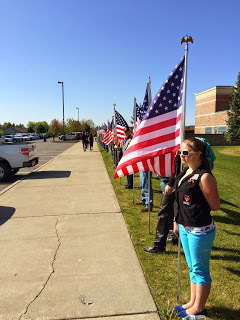
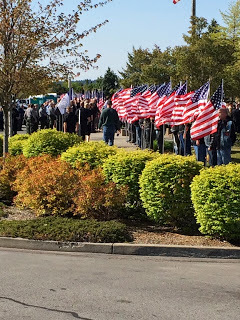 As I parked and made my way to the gymnasium, I was awed to see that a group of citizens, who appeared to be members of various motorcycle clubs, were lined along the sidewalk that led to the gymnasium, each of them holding an American flag, forming a silent salute of gratitude to Sergeant Moore’s memory, and the sacrifice he paid.
As I parked and made my way to the gymnasium, I was awed to see that a group of citizens, who appeared to be members of various motorcycle clubs, were lined along the sidewalk that led to the gymnasium, each of them holding an American flag, forming a silent salute of gratitude to Sergeant Moore’s memory, and the sacrifice he paid.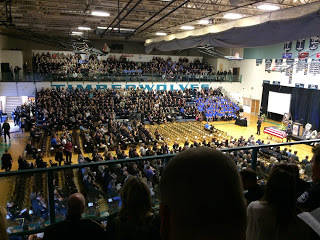 We stood in line for an hour while waiting to be seated, and once we arrived at our seats, I was overwhelmed by the sea of law enforcement officers. From my vantage in the balcony, I was able to estimate that approximately 3,000 officers were gathered to pay their respects. Once the gymnasium was filled to capacity, an overflow area was utilized, complete with television screens and a live broadcast of the ceremony.
We stood in line for an hour while waiting to be seated, and once we arrived at our seats, I was overwhelmed by the sea of law enforcement officers. From my vantage in the balcony, I was able to estimate that approximately 3,000 officers were gathered to pay their respects. Once the gymnasium was filled to capacity, an overflow area was utilized, complete with television screens and a live broadcast of the ceremony.Greg Moore’s funeral was as difficult as you might imagine. Heart wrenching tears and final words were spoken, and most of the people attending were fighting their own tears, despite the fact that the vast majority had never met Sergeant Moore. We were all saddened to discover that he left behind a 10-year-old son and one-year-old daughter, but we were proud to learn that Greg Moore was a stellar husband and father, who invested into his family every chance he could. He was a man who lived without regrets, and whose smile and good humor made him a favorite amongst his peers. After hearing the personal testimonies of what an amazing friend he was, I was deeply saddened that I had not the opportunity to meet him in person and, by the end of the service, I felt as though I lost a friend.
His service was unique in some regards, with sacramental methodology I had never before seen. One such instance occurred when seven members of the honor guard performed a bell ceremony, where a single bell was struck 21 times. Each officer participating in the ceremony individually saluted as the bell was struck, and each took a knee once in response to the bell’s toll. I understand the bell ceremony is part of a standard fireman’s salute to a fallen brethren, and the effect was rather profound.
 Once the ceremony was complete, we assembled in our vehicles to create the procession. In a noble and dignified response, hundreds of police and emergency vehicles followed the Moore family to the cemetery for the interment ceremony. The vehicles stretched across Coeur d’Alene like a blue and red flashing ribbon of honor, weaving through the streets and across town. The display of affection for their fallen comrade was not insignificant.
Once the ceremony was complete, we assembled in our vehicles to create the procession. In a noble and dignified response, hundreds of police and emergency vehicles followed the Moore family to the cemetery for the interment ceremony. The vehicles stretched across Coeur d’Alene like a blue and red flashing ribbon of honor, weaving through the streets and across town. The display of affection for their fallen comrade was not insignificant.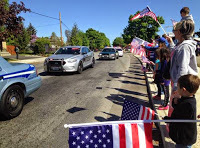 Even more poignant was the citizen response to the funeral. For the entire four-mile journey from the high school to the cemetery, families and individuals lined the streets to display their grief and respect, and demonstrate their unity with the Coeur d’Alene Police Department. The entire length was lined with flags, homemade banners, saluting citizens, and people kneeling on the edge of the road.
Even more poignant was the citizen response to the funeral. For the entire four-mile journey from the high school to the cemetery, families and individuals lined the streets to display their grief and respect, and demonstrate their unity with the Coeur d’Alene Police Department. The entire length was lined with flags, homemade banners, saluting citizens, and people kneeling on the edge of the road. The procession passed one baseball field; the players stood in formation and saluted as the funeral passed. Their solidarity was moving, and there was no doubt that the entire community was grieving Sergeant Moore’s tragic death, in a refreshing response that countered the recent riots in the City of Baltimore.

 One banner was prominently displayed that read, “Cop’s lives matter.” This was the prevailing and unifying theme for the City of Coeur d’Alene, and their heartfelt display could not be mistaken. Cop’s lives do matter, and I’m proud to live in a country where police are respected and honored, and their sacrifices are meaningful. Therefore, I say, may God bless the Greg Moore family, and bring them peace and comfort in the days to come, and may we always remember the sacrifice Sergeant Moore made in order to protect our families from harm. May he rest in peace.
One banner was prominently displayed that read, “Cop’s lives matter.” This was the prevailing and unifying theme for the City of Coeur d’Alene, and their heartfelt display could not be mistaken. Cop’s lives do matter, and I’m proud to live in a country where police are respected and honored, and their sacrifices are meaningful. Therefore, I say, may God bless the Greg Moore family, and bring them peace and comfort in the days to come, and may we always remember the sacrifice Sergeant Moore made in order to protect our families from harm. May he rest in peace.
Published on May 14, 2015 09:10
May 4, 2015
The Places of When Love Called
Cloudcroft. What of it?
 Tressel just outside of town
Tressel just outside of town
I set When Love Calledand the Glenfield Series in the Sacramento Mountains of New Mexico. The Sacramentos are the tail end of the Rocky Mountains as they wind their way south toward Mexico. The Village of Cloudcroft is a very popular vacation destination for just about everyone living in West Texas and Southern New Mexico. There are a few reasons why, and they include the Mescalero Indian Reservation and the casino action available, and the horse racing you can find in the neighboring town of Ruidoso. You can also find great outdoors activities such as skiing and camping throughout the area. Another reason Cloudcroft is a popular destination is because it is generally 20-30 degrees cooler than the surrounding desert, as the Village sits at the top of the mountain about 8,500 feet in elevation. The air is mighty thin at that height!
Many years ago I was re-surfacing from a failed business venture and was searching for what I was supposed to do with my life. Sarah and I had been married for several years, but were still without kids. One weekend, we went to Cloudcroft for a camping trip. While there, I ran into a real estate broker who offered me a job as a real estate agent. Sure, why not? How hard can it be?
We moved to Cloudcroft and give it our best effort. In one year I sold one house, and that was kind of a pity sell from another agent I worked with. Times were hard for us on the mountain. But, we were young enough to still think it was a grand adventure. Later, I joined the Army (for the money!) and thought we left Cloudcroft behind. When my military time was complete, we returned to Cloudcroft where I took another stab at real estate. I’m not a good salesman. I know that now.
 Burro StreetWhen I wrote When Love Called, which is a book about fresh starts and new beginnings, I set it in Cloudcroft because that is what the Village represented in our lives. Some of our worst days and some of our happiest were on that mountain, and we have life-long friendships from our time there. I wanted a place for Caton to build his magnificent estate, and where is there a better place than the Rocky Mountains? Glenfield rose from an isolated, empty meadow with a tiny stream running through it. And from there, a new start for Lily, and new starts for so many others, Jayne included.
Burro StreetWhen I wrote When Love Called, which is a book about fresh starts and new beginnings, I set it in Cloudcroft because that is what the Village represented in our lives. Some of our worst days and some of our happiest were on that mountain, and we have life-long friendships from our time there. I wanted a place for Caton to build his magnificent estate, and where is there a better place than the Rocky Mountains? Glenfield rose from an isolated, empty meadow with a tiny stream running through it. And from there, a new start for Lily, and new starts for so many others, Jayne included.
 Mercantile; the tea shop is next door.Based upon requests from many readers, I have decided to show you some of the places I’ve mentioned in the books. Many of them are actual locations, while the characters themselves are entirely fictional. The main street running through the shopping blocks in Cloudcroft is Burro Street, where the Pine Stump Café is located. This is where Caton is eating lunch with his work crew and discovers that Lily is just across the street eating pizza with Dr. McCranie. What doesn’t actually exist on Burro Street is the Log Cabin Pizza Palace, nor the hospital. There is no hospital in Cloudcroft, and there never will be. But, I needed to have one handy, so wrote it in.
Mercantile; the tea shop is next door.Based upon requests from many readers, I have decided to show you some of the places I’ve mentioned in the books. Many of them are actual locations, while the characters themselves are entirely fictional. The main street running through the shopping blocks in Cloudcroft is Burro Street, where the Pine Stump Café is located. This is where Caton is eating lunch with his work crew and discovers that Lily is just across the street eating pizza with Dr. McCranie. What doesn’t actually exist on Burro Street is the Log Cabin Pizza Palace, nor the hospital. There is no hospital in Cloudcroft, and there never will be. But, I needed to have one handy, so wrote it in.
The next item of discussion is April Poe’s teashop, where Jayne stages the scene where Lily and Caton have a sit down conversation to discuss their relationship. Jayne accidentally triggers a dating contest between Lily and her two incredible love interests: Jack and Caton. The teashop is fictional, but it is set on a location that actually exists. I placed it next to the Mercantile, which was the only grocery store in the Village, and was a landmark for so many years. It was the place to buy fresh pies and donuts.
Another place mentioned is the Crofting, where Susan stayed while Lily was in the hospital, and where Lily and Jayne joined her until the end of the book. I have stayed at the Crofting before, and I have fond memories of spending the Christmas holidays with my family there.
 The CroftingFinally, the location that is most renowned is The Lodge, and Rebecca’s Lounge. Many meals are eaten at The Lodge, and I eat there every chance I get. They have a great menu and offer excellent service. The Lodge is an historical location, and boasts to hosting many celebrities throughout the years. If you’re a fan of Clark Gable, you can see where his initials are carved on a post in the lookout tower. The Lodge also claims to be the residence of a ghost, Rebecca, for whom the restaurant is named. The Lodge is a key location for the story. Lily has her first date at lounge, and Susan meets Caton in the restaurant, and discovers that Caton was significantly injured while rescuing Lily from an impossible car wreck that should have left her dead.
The CroftingFinally, the location that is most renowned is The Lodge, and Rebecca’s Lounge. Many meals are eaten at The Lodge, and I eat there every chance I get. They have a great menu and offer excellent service. The Lodge is an historical location, and boasts to hosting many celebrities throughout the years. If you’re a fan of Clark Gable, you can see where his initials are carved on a post in the lookout tower. The Lodge also claims to be the residence of a ghost, Rebecca, for whom the restaurant is named. The Lodge is a key location for the story. Lily has her first date at lounge, and Susan meets Caton in the restaurant, and discovers that Caton was significantly injured while rescuing Lily from an impossible car wreck that should have left her dead.
 The Lodge. Photo by Robert FlahertyOf course, I’d love to post photos of Glenfield, itself. Sadly, there are none. If you find a worthy candidate, let me know!
The Lodge. Photo by Robert FlahertyOf course, I’d love to post photos of Glenfield, itself. Sadly, there are none. If you find a worthy candidate, let me know!
There’s too much of the story to tell here, so feel free to check it out! When Love Called is a fantastic story, and is very popular. You can get more information at my website, www.traviswinman.com
We’ll see you there!
 Tressel just outside of town
Tressel just outside of townI set When Love Calledand the Glenfield Series in the Sacramento Mountains of New Mexico. The Sacramentos are the tail end of the Rocky Mountains as they wind their way south toward Mexico. The Village of Cloudcroft is a very popular vacation destination for just about everyone living in West Texas and Southern New Mexico. There are a few reasons why, and they include the Mescalero Indian Reservation and the casino action available, and the horse racing you can find in the neighboring town of Ruidoso. You can also find great outdoors activities such as skiing and camping throughout the area. Another reason Cloudcroft is a popular destination is because it is generally 20-30 degrees cooler than the surrounding desert, as the Village sits at the top of the mountain about 8,500 feet in elevation. The air is mighty thin at that height!
Many years ago I was re-surfacing from a failed business venture and was searching for what I was supposed to do with my life. Sarah and I had been married for several years, but were still without kids. One weekend, we went to Cloudcroft for a camping trip. While there, I ran into a real estate broker who offered me a job as a real estate agent. Sure, why not? How hard can it be?
We moved to Cloudcroft and give it our best effort. In one year I sold one house, and that was kind of a pity sell from another agent I worked with. Times were hard for us on the mountain. But, we were young enough to still think it was a grand adventure. Later, I joined the Army (for the money!) and thought we left Cloudcroft behind. When my military time was complete, we returned to Cloudcroft where I took another stab at real estate. I’m not a good salesman. I know that now.
 Burro StreetWhen I wrote When Love Called, which is a book about fresh starts and new beginnings, I set it in Cloudcroft because that is what the Village represented in our lives. Some of our worst days and some of our happiest were on that mountain, and we have life-long friendships from our time there. I wanted a place for Caton to build his magnificent estate, and where is there a better place than the Rocky Mountains? Glenfield rose from an isolated, empty meadow with a tiny stream running through it. And from there, a new start for Lily, and new starts for so many others, Jayne included.
Burro StreetWhen I wrote When Love Called, which is a book about fresh starts and new beginnings, I set it in Cloudcroft because that is what the Village represented in our lives. Some of our worst days and some of our happiest were on that mountain, and we have life-long friendships from our time there. I wanted a place for Caton to build his magnificent estate, and where is there a better place than the Rocky Mountains? Glenfield rose from an isolated, empty meadow with a tiny stream running through it. And from there, a new start for Lily, and new starts for so many others, Jayne included.  Mercantile; the tea shop is next door.Based upon requests from many readers, I have decided to show you some of the places I’ve mentioned in the books. Many of them are actual locations, while the characters themselves are entirely fictional. The main street running through the shopping blocks in Cloudcroft is Burro Street, where the Pine Stump Café is located. This is where Caton is eating lunch with his work crew and discovers that Lily is just across the street eating pizza with Dr. McCranie. What doesn’t actually exist on Burro Street is the Log Cabin Pizza Palace, nor the hospital. There is no hospital in Cloudcroft, and there never will be. But, I needed to have one handy, so wrote it in.
Mercantile; the tea shop is next door.Based upon requests from many readers, I have decided to show you some of the places I’ve mentioned in the books. Many of them are actual locations, while the characters themselves are entirely fictional. The main street running through the shopping blocks in Cloudcroft is Burro Street, where the Pine Stump Café is located. This is where Caton is eating lunch with his work crew and discovers that Lily is just across the street eating pizza with Dr. McCranie. What doesn’t actually exist on Burro Street is the Log Cabin Pizza Palace, nor the hospital. There is no hospital in Cloudcroft, and there never will be. But, I needed to have one handy, so wrote it in.The next item of discussion is April Poe’s teashop, where Jayne stages the scene where Lily and Caton have a sit down conversation to discuss their relationship. Jayne accidentally triggers a dating contest between Lily and her two incredible love interests: Jack and Caton. The teashop is fictional, but it is set on a location that actually exists. I placed it next to the Mercantile, which was the only grocery store in the Village, and was a landmark for so many years. It was the place to buy fresh pies and donuts.
Another place mentioned is the Crofting, where Susan stayed while Lily was in the hospital, and where Lily and Jayne joined her until the end of the book. I have stayed at the Crofting before, and I have fond memories of spending the Christmas holidays with my family there.
 The CroftingFinally, the location that is most renowned is The Lodge, and Rebecca’s Lounge. Many meals are eaten at The Lodge, and I eat there every chance I get. They have a great menu and offer excellent service. The Lodge is an historical location, and boasts to hosting many celebrities throughout the years. If you’re a fan of Clark Gable, you can see where his initials are carved on a post in the lookout tower. The Lodge also claims to be the residence of a ghost, Rebecca, for whom the restaurant is named. The Lodge is a key location for the story. Lily has her first date at lounge, and Susan meets Caton in the restaurant, and discovers that Caton was significantly injured while rescuing Lily from an impossible car wreck that should have left her dead.
The CroftingFinally, the location that is most renowned is The Lodge, and Rebecca’s Lounge. Many meals are eaten at The Lodge, and I eat there every chance I get. They have a great menu and offer excellent service. The Lodge is an historical location, and boasts to hosting many celebrities throughout the years. If you’re a fan of Clark Gable, you can see where his initials are carved on a post in the lookout tower. The Lodge also claims to be the residence of a ghost, Rebecca, for whom the restaurant is named. The Lodge is a key location for the story. Lily has her first date at lounge, and Susan meets Caton in the restaurant, and discovers that Caton was significantly injured while rescuing Lily from an impossible car wreck that should have left her dead. The Lodge. Photo by Robert FlahertyOf course, I’d love to post photos of Glenfield, itself. Sadly, there are none. If you find a worthy candidate, let me know!
The Lodge. Photo by Robert FlahertyOf course, I’d love to post photos of Glenfield, itself. Sadly, there are none. If you find a worthy candidate, let me know!There’s too much of the story to tell here, so feel free to check it out! When Love Called is a fantastic story, and is very popular. You can get more information at my website, www.traviswinman.com
We’ll see you there!
Published on May 04, 2015 13:03



